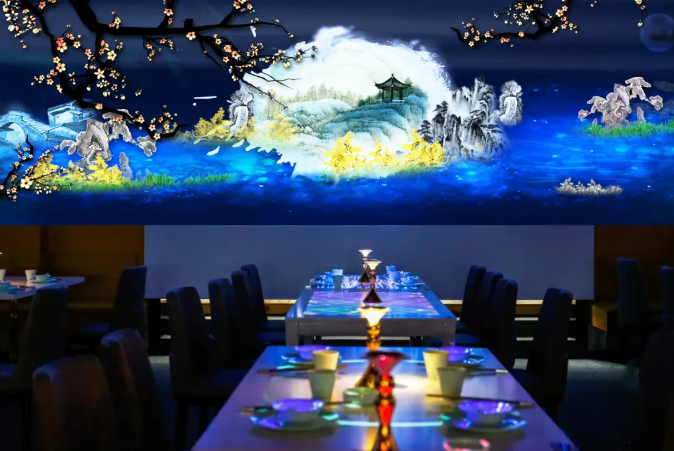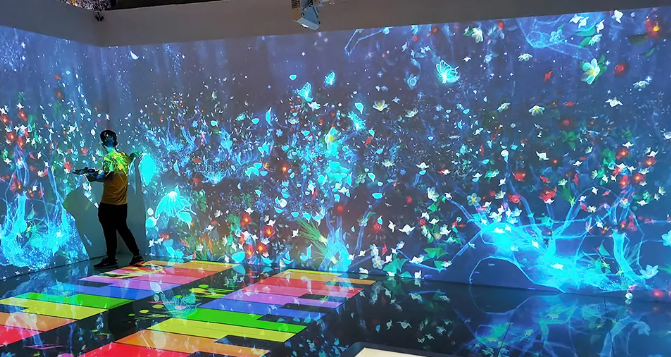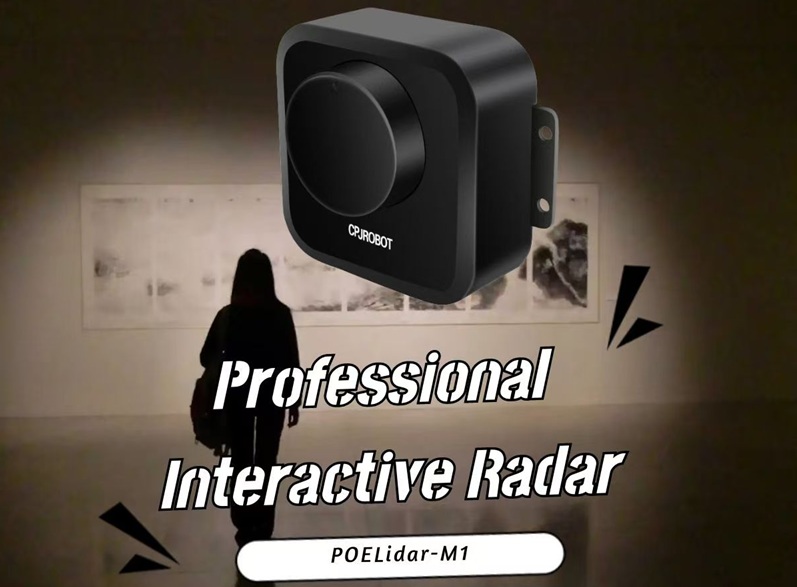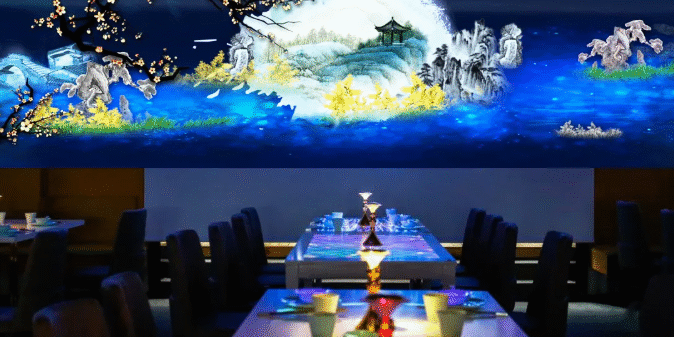What Is an Interactive Projection Restaurant?
An interactive projection restaurant combines advanced projection mapping, LiDAR sensing, and real-time interaction to create a fully immersive dining experience.
Guests are no longer just eating — they are part of a digital performance, surrounded by moving visuals, reactive lighting, and sound that respond to their gestures and actions.
These restaurants are often called “holographic restaurants,” “5D immersive dining,” or “3D projection restaurants.”
Whether it’s a holographic hotpot, light-and-shadow KTV restaurant, or wedding banquet hall, the technology behind them is the same — dynamic projection and smart sensing.

How Does an Interactive Projection Restaurant Work?
The system uses multiple projectors to create panoramic visual effects across walls, tables, and floors.
Each projector is aligned through edge blending and correction software, forming one seamless scene.
When combined with CPJROBOT’s POE LiDAR interactive sensing system, the projection reacts instantly to touch, movement, or proximity.
Working Process Overview
- Detection: LiDAR sensors capture guests’ gestures or motion in real time.
- Processing: The main controller analyzes the data and determines the interaction point.
- Display Response: The system synchronizes visuals and sound to react dynamically — waves ripple, lights bloom, or virtual petals scatter at your touch.
The result: a dining space that feels alive and responsive, creating a sense of wonder and engagement impossible with traditional décor.
The Power Behind It — CPJROBOT POE LiDAR Technology
As the core sensing solution of many modern interactive restaurants, CPJROBOT POE LiDAR offers unmatched accuracy, flexibility, and reliability compared to traditional infrared or camera-based systems.
Key Advantages
- ⚡ Multi-Touch Radar Interaction
- Supports multiple guests interacting simultaneously across large surfaces.
- Perfect for group dining, themed events, and entertainment zones.
- 🔌 PoE Power Supply (Plug & Play)
- One Ethernet cable provides both power and data.
- Simplifies installation — no external power adapter or complex wiring needed.
- 🎯 No Manual Calibration Required
- The system automatically detects space and adjusts positioning.
- Greatly reduces setup time and eliminates traditional alignment errors.
- 🌀 Wide Detection Range (270°/360°)
- Covers entire walls or floors seamlessly, even in irregularly shaped spaces.
- Supports cascading multiple sensors for ultra-wide or multi-zone setups.
- 💡 Anti-Interference & High Stability
- Works perfectly under bright light or mixed illumination.
- Immune to dust, reflections, and overlapping signals — ideal for busy dining environments.
- 🎮 Free Interactive Software & SDK
- Includes 100+ preloaded interactive scenes and visual games.
- Supports secondary development and content customization for restaurant themes.
With CPJROBOT’s POE LiDAR, every dining table, wall, or floor becomes an interactive storytelling canvas.

Core Features of an Interactive Projection Restaurant
- Immersive Environment: Surround guests with vivid 3D visuals and responsive soundscapes.
- Flexibility in Design: Any surface — wall, floor, ceiling, or tabletop — can become an interactive display.
- Multi-Sensory Experience: Combines sight, sound, touch, taste, and smell into one seamless event.
- Simple Decoration Needs: A white wall and imagination are enough — no heavy interior décor required.
- Trend-Setting Appeal: Combines art, technology, and dining for a futuristic brand identity.
Types of Interactive Projection in Restaurants
Depending on space and theme, various projection forms can be used individually or in combination:
- Holographic Welcome Entrance – dynamic greetings and brand animations.
- Interactive Wall Projection – immersive ambient scenes or playful effects.
- Interactive Floor Projection – touch-sensitive floors that react to footsteps.
- Interactive Dining Table Projection – allows customers to play, order, or interact while dining.
- Stage or Wedding Projection Mapping – cinematic storytelling for banquets or shows.
Each projection type can be customized to fit the restaurant’s concept, space size, and target audience.
System Composition
Hardware
- Projectors (high-lumen laser models recommended)
- Projection media (walls, tables, floors, or curved surfaces)
- Ceiling mounts or brackets
- Control host & main computer
- CPJROBOT POE LiDAR sensors
- Signal and power cables
Software
- Projection fusion and calibration tools
- Interactive content software
- Control and management system (scene switching, scheduling, analytics)
How to Choose the Right Interactive Projection Partner
Choosing the right manufacturer determines your project’s success.
Here’s what to evaluate before investing:
- Interactive Content Quality: Is the visual content original, artistic, and customizable?
- Hardware Reliability: Are the sensors, projectors, and controllers stable and certified?
- After-Sales Support: Does the supplier offer on-site installation, calibration, and technical support?
- Real Project References: Visit a working site or demo showroom whenever possible.
- Software Ecosystem: Does it support SDKs or integration with your restaurant’s POS or lighting system?
👉 CPJROBOT provides full-system solutions — from POE LiDAR sensors and controllers to calibration software and content customization — ensuring one-stop service from concept to installation.
What Determines the Cost of an Interactive Projection Restaurant?

There’s no single fixed price, as it depends on multiple factors:
- Projection Area & Size — Larger spaces require more projectors and sensors.
- Indoor or Outdoor Environment — Outdoor setups need weatherproof enclosures.
- Brightness of Venue — Brighter spaces demand higher-lumen projectors.
- Equipment Specifications — Sensor range, projection resolution, and processing power.
- Design Complexity & Custom Content — The more creative the theme, the higher the customization cost.
Share your floor plan and concept with CPJROBOT — we’ll tailor the most cost-effective solution for your restaurant project.
Expert Tips for Building an Interactive Dining Experience
- Clarify Your Vision First: Outline your goals and themes before requesting quotations.
- Avoid the “Lowest Price” Trap: Quality projection systems need reliable hardware and professional service.
- Invest in Visual Content: Artistic, emotionally engaging visuals keep guests coming back and sharing online.
Why Interactive Dining Is the Future
The modern diner seeks experiences, not just meals.
Interactive projection restaurants combine technology, storytelling, and gastronomy — turning every dinner into a memory.
With CPJROBOT’s POE LiDAR, these experiences become smarter, more reliable, and infinitely scalable.
Frequently Asked Questions (FAQ)
Q1: What makes LiDAR better than infrared or cameras for restaurant projection?
A: LiDAR uses laser-based time-of-flight technology, unaffected by ambient lighting or shadows — ideal for restaurant environments with variable brightness.
Q2: Can one LiDAR sensor cover an entire restaurant?
A: Typically, multiple sensors are used. CPJROBOT supports multi-unit cascading to cover large or complex spaces seamlessly.
Q3: How long does installation take?
A: Thanks to POE design and auto-calibration, installation is fast — usually within 1–2 days, depending on size.
Q4: Can I customize the interactive content?
A: Yes. CPJROBOT provides SDKs and content-editing tools, allowing full customization for branding, events, and seasonal themes.
Conclusion
Interactive projection restaurants represent the fusion of art, technology, and dining.
They create unforgettable experiences that attract crowds, strengthen brand identity, and set new trends in the hospitality industry.
With CPJROBOT POE LiDAR, restaurants can easily build multi-touch, high-precision interactive environments — without complex calibration or high maintenance.







